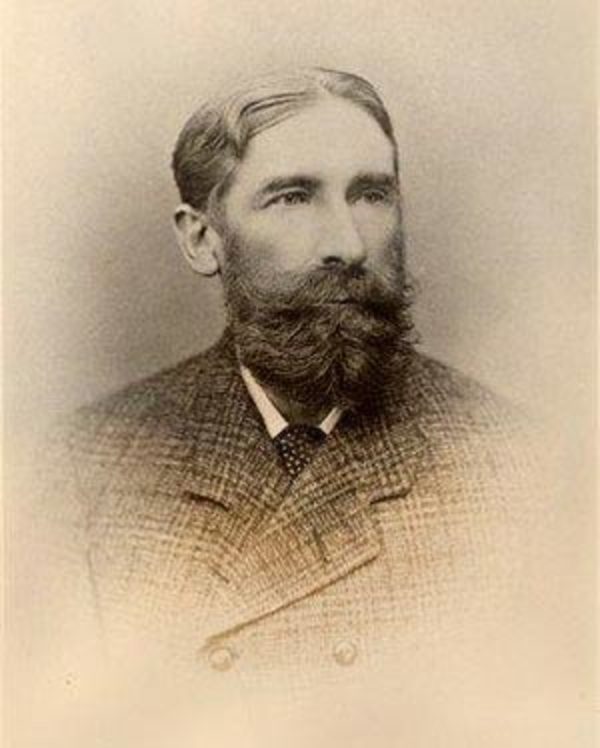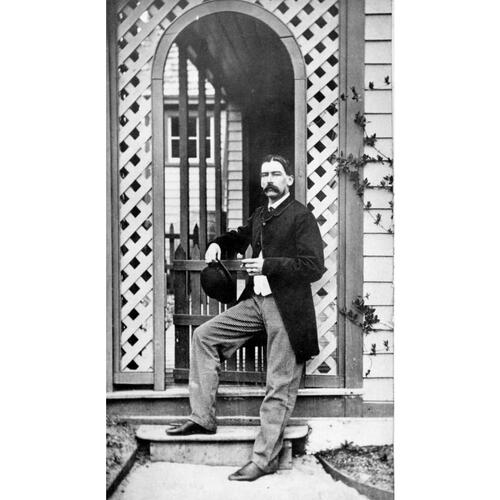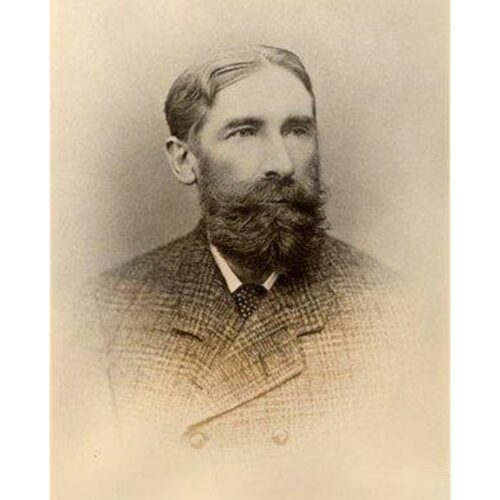
Source: Link
HAYNES, JOHN CARMICHAEL, public servant and rancher; b. 6 July 1831 at Landscape, County Cork (Republic of Ireland), eldest son of Jonas Haynes and Hester Carmichael; m. 6 Sept. 1868 Charlotte Moresby (d. 1872) at Hope, B.C., and they had one son; m. secondly 14 Jan. 1875 Emily Josephine Pittendrigh, at Osoyoos, B.C., and they had three sons and three daughters; d. 6 July 1888 at Princeton, B.C.
John Carmichael Haynes left Ireland in 1858, hoping to join the police force which Chartres Brew*, a friend of his uncle, expected to establish in British Columbia. On board the Sonora from Panama, he became acquainted with Colonel Richard Clement Moody, Arthur Thomas Bushby*, and Thomas Elwyn. “Paddy” Haynes made a good impression: Bushby considered him “a decent sort of a fellow.” They arrived in Victoria on Christmas Day 1858, and early in January 1859 Governor James Douglas* appointed Haynes and Elwyn special constables to accompany Brew on an expedition to quell disturbances among the gold-miners at Hills Bar. After order was restored Brew employed Elwyn and Haynes briefly to collect miners’ licences. They were not particularly successful but Brew was satisfied that they were competent and would perform any duty “with zeal and fidelity.” Haynes then served at Yale as a constable under Magistrate Edward Howard Sanders, and in November 1859 was promoted to acting chief constable.
The next year Governor Douglas chose Haynes to assist William George Cox*, the justice of the peace, assistant gold commissioner, and deputy collector of customs at Rock Creek, inland near the international boundary line, where gold had been found. In this open range country around the Kettle River, it was easy for American traders, cattlemen, and mule-drivers to gain access. Douglas, to divert commerce to British hands, ordered the Hope-Princeton Trail built over the Cascade Mountains and stationed Cox and Haynes at Rock Creek. Haynes arrived there on 15 Oct. 1860. Six weeks later Cox sent him to Similkameen, the scene of another gold flurry, where he opened a customs house in December. That same month Douglas imposed along the southern boundary customs duties and tolls on imported animals. In 1861 the Cariboo gold rush drew miners northward and by November the last had left Rock Creek. Inland traffic into British Columbia from American territories now passed through the Okanagan valley and Haynes was moved to Osoyoos Lake where he assumed responsibility for the whole area of Rock Creek, Okanagan, and Similkameen. He became deputy collector of customs in March 1862, a year in which 800 men and over 9,000 cattle, horses, and mules passed through his station, and he collected more than £2,200 in revenue. The heavy movement of men and animals continued throughout 1863 and into the early months of 1864, but then cattle ranches, established by drivers in the interior valleys, began to supply the food requirements of the Cariboo District and the cattle drives declined.
Haynes was transferred to the Kootenay District as justice of the peace and assistant gold commissioner in June 1864. After an arduous 20-day trip by way of Fort Colvile (Colville) and Fort Spokane (near Spokane) in Washington Territory, he arrived on 10 August at Wild Horse Creek (Wild Horse River, B.C.) where a camp of 1,000 miners, shopkeepers, and labourers had sprung into existence. In this predominantly American community lawlessness prevailed, but Haynes vigorously applied the colony’s mining and revenue laws. Six weeks after his arrival, when Arthur Nonus Birch, the colonial secretary of British Columbia, and Arthur Bushby made an official visit to the camp, they found “no pistols to be seen, and everything as quiet and orderly as it could possibly be in the most civilized district of the colony.” Haynes turned over to them 75 lbs of gold, the revenue collected on imports he had found when he arrived. In recognition of his work, Governor Frederick Seymour* appointed him a member of the Legislative Council.
Attendance at the 1865 and 1866 sessions of the council strengthened Haynes’s ties with government officials. These associations proved helpful: in 1865 he obtained permission to reduce the size of the two large Indian reserves at the head and foot of Okanagan Lake, thus making meadow and range lands available for white settlement. That year Haynes also supervised the construction of a new customs house at “the narrows” of Osoyoos Lake, but he spent most of that year and the following spring at Fort Shepherd on the Columbia River. In August 1866 during the brief rush at Big Bend he was appointed district court judge at French Creek, but soon returned to Osoyoos as collector of customs. In November, when the colonies of British Columbia and Vancouver Island were united, Haynes remained on the civil list as deputy collector of customs for the southern boundary.
Unexpectedly Haynes was ordered to return to Wild Horse Creek as magistrate and district court judge in the summer of 1870. He protested being sent to “the most out of the way & unpleasant station in the colony,” the “great Personal inconvenience” of the move, and the salary of £450, which was less than that received by other magistrates. He travelled to Victoria in the winter of 1870–71 to seek an adjustment. Governor Anthony Musgrave, who was then making recommendations on the future of the colony’s public servants after its entry into confederation, privately felt that Haynes’s appointments as magistrate and judge had been “temporary” and that he should be superannuated though allowed to transfer to the federal customs department. But Haynes was needed in Kootenay, and remained at Wild Horse Creek as a magistrate and district court judge until 1872, when he returned to Osoyoos as justice of the peace and also served in the federal customs department until his death.
His income assured, Haynes rapidly expanded his land holdings after 1872. In August 1869, with his partner, Constable William Hamilton Lowe, he had acquired 160 acres of land at the head of Osoyoos Lake, to which he added an adjoining 480-acre tract the following year. In 1872, after Lowe suffered a severe accident, Haynes absorbed his lands, and further acquisitions between 1874 and 1888 increased his holdings to 20,756 acres. He established a horse ranch but could not find a market, and turned to cattle ranching, eventually increasing his herd to 4,000 head and acquiring the title of “The Cattle-King of the South Okanagan.” He made cattle drives over the Hope Trail to New Westminster and over the Dewdney Trail to Kootenay and Calgary (Alta). After he built a fine house on the eastern shore of Osoyoos Lake in 1882, it was rumoured that his properties had a value of $200,000.
In 1888, while returning over the Hope Trail with his two sons who had been at school in Victoria, Haynes was taken ill. He died on 6 July at the home of John Fall Allison at Princeton and was buried at Osoyoos. His lands and cattle passed to Thomas Ellis whom Haynes had earlier befriended as a young Irish immigrant. Haynes had carried out his duties in Osoyoos and the Kootenay firmly and yet without offence to American miners, traders, and drivers. With other Irish landed proprietors he later shared a comfortable life as a country squire in a pastoral setting and with them established cattle ranching as the first industry of the Okanagan.
PABC, Add. mss 180; B.C., Colonial secretary, Corr. outward, 1859–69 (letterbook); Dept. of Lands and Works, Corr. outward, 1865–66; Colonial corr., Chartres Brew corr.; W. G. Cox corr.; J. C. Haynes corr.; GR 112; GR 495; Herald Street coll.; O’Reilly coll., Emily Haynes to Peter O’Reilly, 3 Aug. 1888; Vancouver Island, Governor (Douglas), Corr. outward, 27 May 1859–9 Jan. 1864 (letterbook). [Susan Allison], A pioneer gentlewoman in British Columbia; the recollections of Susan Allison, ed. M. A. Ormsby (Vancouver, 1976). B.C., Blue book, 1859–70; Legislative Assembly, Journals, 1877. [A. T. Bushby], “The journal of Arthur Thomas Bushby, 1858–1859,” ed. Dorothy Blakey Smith, BCHQ, 21 (1957–58): 83–198. Matthew Macfie, Vancouver Island and British Columbia: their history, resources, and prospects (London, 1865), 255–62. Daily Colonist (Victoria), 11 July 1888. Government Gazette–British Columbia (New Westminster, B.C.), 5 Nov. 1864. Kelowna Courier and Okanagan Orchardist (Kelowna, B.C.), 12 March 1908. R. E. Cail, Land, man, and the law: the disposal of crown lands in British Columbia, 1871–1913 (Vancouver, 1974). M. A. Ormsby, “Some Irish figures in colonial days,” BCHQ, 14 (1950): 61–82. H. E. White, “John Carmichael Haynes: pioneer of the Okanagan and Kootenay,” BCHQ, 4 (1940): 183–201.
Cite This Article
Margaret A. Ormsby, “HAYNES, JOHN CARMICHAEL,” in Dictionary of Canadian Biography, vol. 11, University of Toronto/Université Laval, 2003–, accessed January 1, 2026, https://www.biographi.ca/en/bio/haynes_john_carmichael_11E.html.
The citation above shows the format for footnotes and endnotes according to the Chicago manual of style (16th edition). Information to be used in other citation formats:
| Permalink: | https://www.biographi.ca/en/bio/haynes_john_carmichael_11E.html |
| Author of Article: | Margaret A. Ormsby |
| Title of Article: | HAYNES, JOHN CARMICHAEL |
| Publication Name: | Dictionary of Canadian Biography, vol. 11 |
| Publisher: | University of Toronto/Université Laval |
| Year of publication: | 1982 |
| Year of revision: | 1982 |
| Access Date: | January 1, 2026 |




